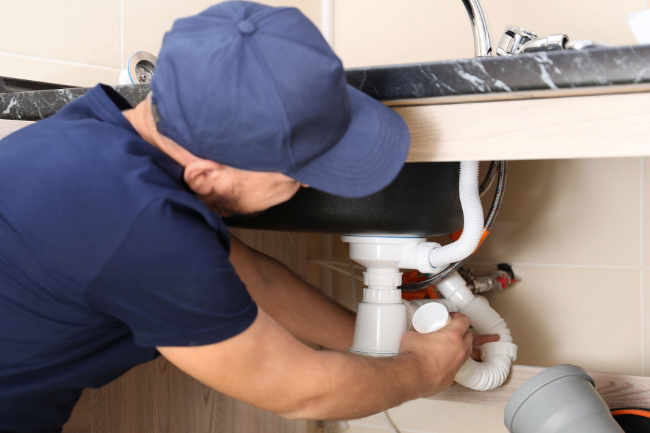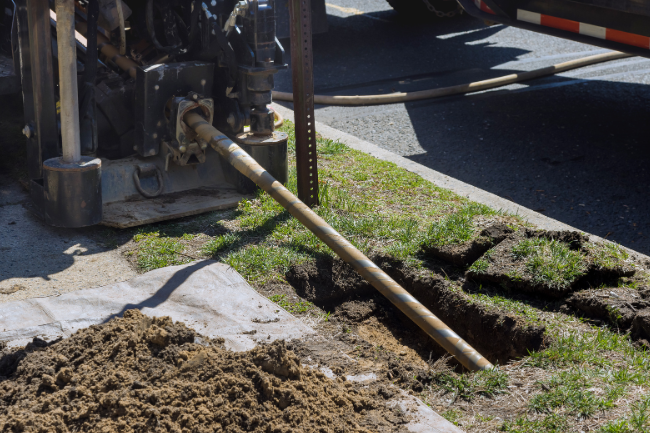5 Ways to Save on Trenchless Water Line Replacement Cost
Posted by William Heinselman on

Leaky pipes and flooded floors are not ideally what people enjoy coming home to after a tiring work day. Who wants to deal with trying DIY plumbing repair quick fixes and attempting to find an after-hours plumbing service, on top of cleaning up in an attempt to limit water damage? You guessed it- no one does.
Luckily trenchless water line replacement is a great, cost-effective solution to help you in times of need. Keep reading to learn more about trenchless water line replacement costs.
Traditional vs. Trenchless Water Line Replacement Cost
Traditional pipe repair methods often come with short lifespan expectations and a significant financial burden. These conventional techniques, while familiar, can disrupt daily life with extensive excavation and long periods of construction. Trenchless pipe repair, in contrast, offers a cost-effective solution for replacing damaged pipes and preventing future issues without the extensive disruptions of traditional methods.
One of the major advantages of trenchless pipe repair is its cost-efficiency. Although the upfront costs of trenchless technology may align with those of traditional pipe repair, the overall expenses incurred are substantially lower. This saving is largely due to the reduced need for labor, as trenchless repair requires fewer workers and less time to complete. Additionally, the avoidance of large-scale excavations means less damage to landscaping and infrastructure, further reducing the restoration costs post-repair.
Furthermore, trenchless lining pipes boast a significantly longer lifespan compared to their traditional counterparts. This durability means fewer repairs and replacements over time, offering long-term savings and convenience. The installation or repair process of trenchless piping is impressively swift, often taking just a few hours to complete. This efficiency minimizes disruption to daily activities, making it an attractive option for both residential and commercial property owners.
While traditional pipe repair methods are burdened by high costs and short lifespans, trenchless pipe repair emerges as a superior alternative. It not only offers an affordable and less intrusive solution but also ensures durability and efficiency, making it an increasingly popular choice in modern infrastructure maintenance.
5 Different Ways to Save on Trenchless Water Line Replacement Costs

Unlike traditional methods that require an extensive amount of digging and have a long installation process, trenchless methods generally abide by one main concept: minimal digging!
There are a variety of ways that trenchless methods can be applied, depending on the damaged pipe in question or unique repair needs.
Below are five different ways that trenchless water line replacement can help save both your home and your money.
1.) CIPP
Cured-in-place pipe is used primarily for boosting the strength of pre-existing pipes. This method of trenchless involves simply relining the pipe using a seamless, PVC-infused liner that fills in the existing holes and cracks.
Before the liner is applied, Express uses a process called hydro-jetting to clean the pipe in its entirety. Once the liner is placed, it is sealed using highly pressurized steam. This method is best used for minor pipe damage because the pipe needs to be durable enough to withstand the lining process.
2.) Pipe Bursting
This trenchless process is best used for replacing an entire water or sewer pipe. It involves using a spear-shaped tool called a “bursting head,” which is attached to the opposite end of a replacement pipe and fed through the deteriorated pipe via cable.
It is called pipe bursting because the cone-shaped head bursts the existing pipe into pieces from within while laying the new pipe in a single, seamless process. For a more thorough understanding of the pipe bursting process and when it is used, click here.
3.) Pipe Replacement
Like standard pipe lining, this form of trenchless repair utilizes CIPP, as well. The replacement process begins when repair technicians insert a small cable machine into the pipe being replaced. Attached to the machine is a smaller pipe, which is then dragged through the old pipe, sealed in-place, and functions within the old pipe.
This method is ideal for extremely old or decayed pipes that are unable to be lined.
4.) Pull-in-Place Lining
This method is similar to pipe bursting, in that it only requires two small holes to be dug. The new liner is pulled through the pipe using a wench and is steam-sealed. Like CIPP, the pipe must be durable enough to withstand this process.
Pull-in-place lining is used to cure small pipe imperfections and add strength; however, it does not replace the pipe’s structure entirely.
5.) Inversion Lining
Another way to add durability and fill in any cracks or spacing in a pipe is using inversion lining. In inversion lining, the liner material is made of a felt tube and put/pulled into place like the previously mentioned trenchless methods.
Should you go Trenchless?
Trenchless repair methods go beyond just repairing and replacing pipes; they can also be used to prevent future pipe damage. Realistically, no one enjoys water invading their homes and damaging their property. Repairing damaged pipes using traditional methods can get pricey and use an extensive amount of resources. Going trenchless is not just affordable - it’s also preventative.
If you have questions about trenchless water line replacement costs, reach out to the team at Express Sewer today.
Topics: Pipe Bursting, Trenchless Technology, Pipe Leaks and Repair






